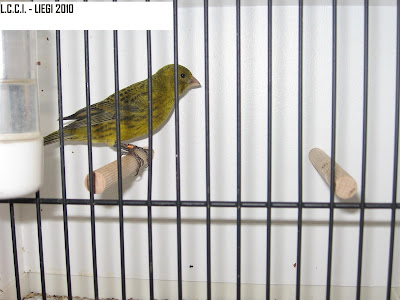
The difference between male (cock) and female (hen) in silver and gold:
The gold has in general less rowlings and the sprangles are often better, these are more fine and smaller. Both have to be in good lines, symmetrical and interrupt. At the silver the rowlings and sprangles are often wider and at the better lizards these are less, of course. The rowlings at the gold are often less but at the better ones can these be clearly present. The flanks has to be interrupt as well, these are often stripes, what isn’t good of course. At the silver the rowlings are often better and clear but often also less small. What also is important is the ground color, this has to be clear and has to have less brown in the back as possible. It will help to give the birds a lot of sunlight to get the brown out of them. At the silver the cap is often too yellow above the beak and in the breast (these are often males). They are already too intensive, these have to have uniform colors. Multicolored pigment is not allowed.
To obtain black legs, you can do the following:
• Put the birds outside on the black ground. The birds should be put outside from 5-6 weeks till the first exhibition.
• Give them Fallopia baldschuanica, Polygonum aubertii, the flowers as well the stalk.
• Give them Spirulina and dried seaweed (can be given through the egg food)
When you put your birds in the cage inside you have to keep feeding them this and let them bath regular. Not only the legs have to be as black as possible but also the beak has to be as black as possible. You also have to select on this for your further breed. A light nail isn’t allowed.
Cap:
For a full cap is it important that the cap doesn’t run on to the neck and the stripe between the eye and the cap has to be visible (eyelashes).
Broken cap:
At the interrupted part the broken has to be fine scaly.
Non cap:
The scaly drawing begins at the beak.
Wings and tail:
The wing feathers have to be black without bright tips. If they have bright tips they are generally came back for the second time (pick).
The tail feathers have t be black and closed as well. Here also no bright tips (generally came back for the second time).
Select the older birds: the birds with less bright tips as possible and bright feathers you have to use for further breed.
Covert feathers:
Have to be black and well lined, in the shape of a comma.
Size:
The size is 12,5 cm. How better the size, how nicer and finer the drawing. With birds who are larger, you will have more wider and rougher stripes. The condition of the birds has to be purely and well cared, so no bristles of the moulting, broken tail feathers, a dirty abdomen (stools) and clean legs.
The best of the show was a hen gold from F. Coppelli, it was a beautiful lizard in the rowlings and sprangles. The only problem were the legs but I’ve seen that the legs were a problem at all the lizards. I think that this problem has to do with your climate. But if you do what I’ve described above (to obtain black legs) I’m sure that it will help to obtain darker (black) legs. The best of the show also had a good ground color and a beautiful cap. I’ve seen a lot of lizards with a good ground color, only the silver ones were a little bit to intensive in the cap. This I have also seen at the best in show opposite sex from P. Caianiello. This has to be a cock silver, but we weren’t sure. I have breed such cocks as well, and it can. This is always difficult for the judge to determine if it is a cock or a hen. You only can be sure during the breed or if you check the DNA. Because of this we don’t have cock and hen groups in Holland, there are just going together in one group.
The best in show stamm from F. Coppeli was having a very good ground color and they were bright of color. Only you have to pay attention that if you send in a stamm that all the caps have to be the same as much as possible. And especially by the silver you have to pay attention that the ground color isn’t too intensive for the head and on the cap, the birds have to be the same as much as possible.
Finally I have one more thing: the size of the birds. I’ve seen some birds who were too big or too small. You have to try to breed a compact bird who is good into the meat, not too fat because they will lose their shape and this affects the rowlings.
I hope that everything is clear, it was a little bit difficult for me to write everything down in English, my English isn’t that great and I don’t know all the terms and words in English that we use during a judgment here in Holland. I hope that I have given a good impression of the birds of your show. I have enjoyed the judgment, the show and my stay in Bologna. I want to thank everyone for the hospitality and sociability. I hope to see you another time and I wish everyone a very good breed and a lot of pleasure with this great hobby.
Best regards,
Hans Stevens
La traduzione sul prossimo numero del Lizard news - 2010































